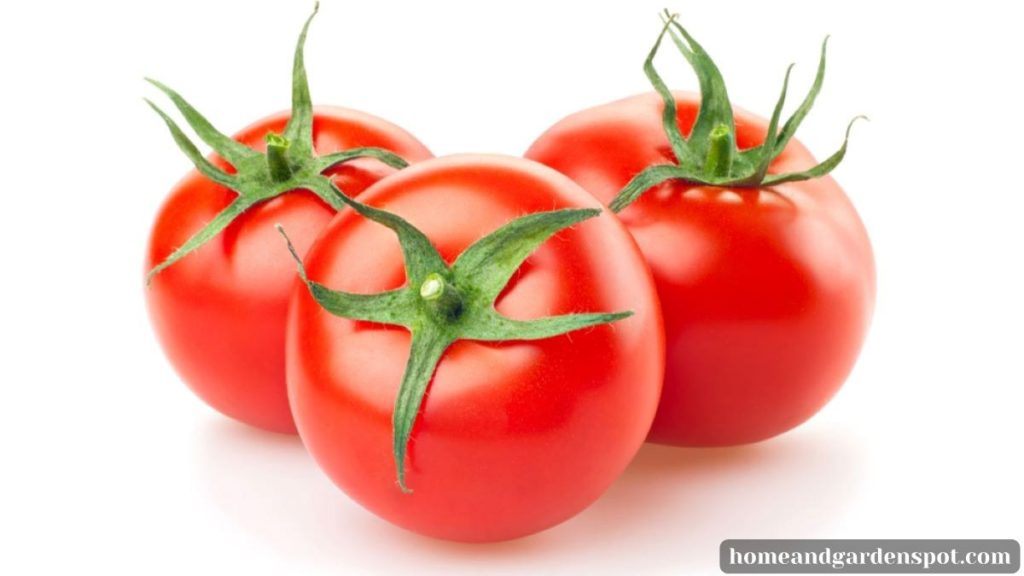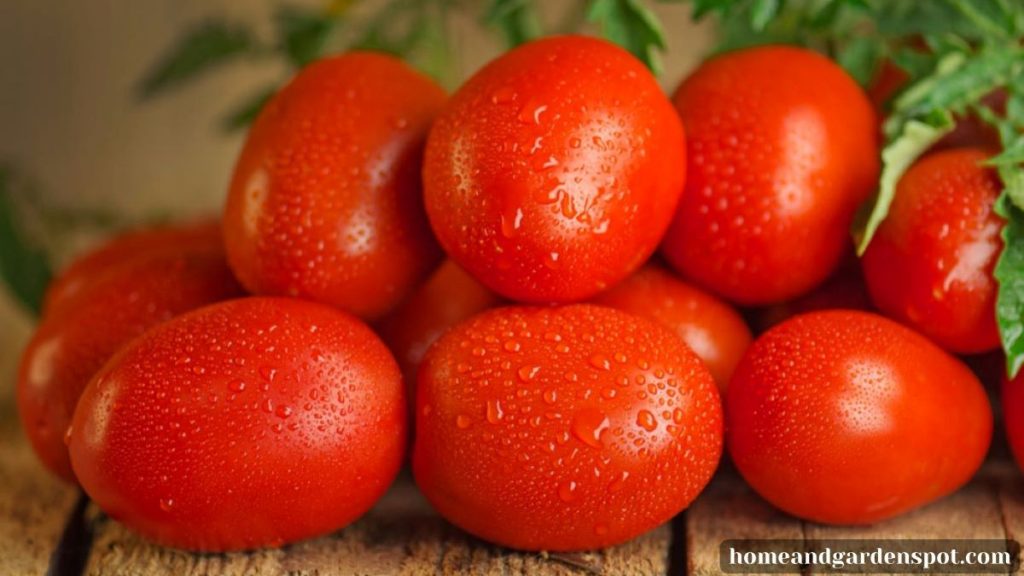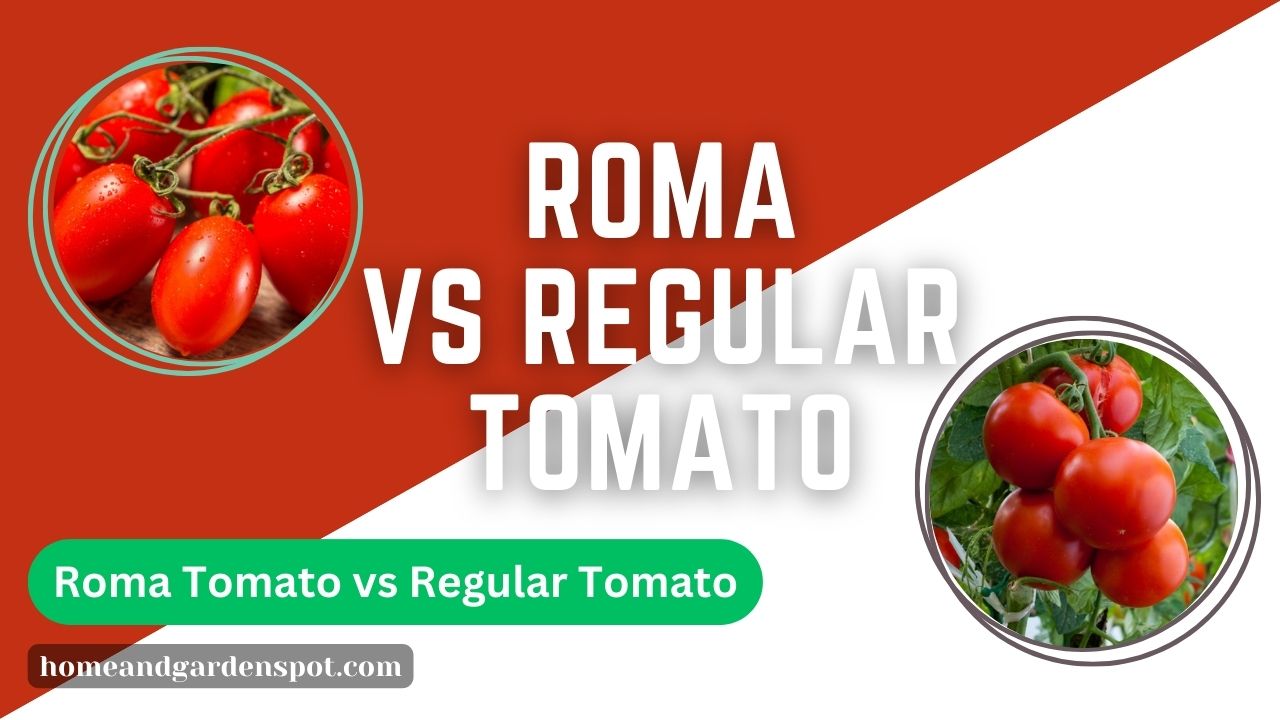Tomatoes are among the world’s most popular and versatile fruits. They come in many varieties, shapes, sizes, and colors. Two common types of tomatoes are Roma tomatoes and regular tomatoes. But what are their differences, and how can they be used in cooking?
The major difference is that Roma tomatoes are long and meaty with few seeds, while regular tomatoes are round, juicy, and flavorful. Also, Roma tomatoes are best for making tomato paste and sauce, unlike regular tomatoes, which are better suited for raw consumption.
In this blog post, I’ll compare these fruits to help you choose where to plant each variety and select the perfect tomato for your culinary creations.
Comparison Between Roma Tomatoes and Regular (Round) Tomatoes
1. Shape and Size
Roma tomatoes are elongated and oblong with fewer seeds. They’re typically smaller and have a cylindrical shape. As the name suggests, round tomatoes are round and come in various sizes, from petite cherry tomatoes to large beefsteak varieties.


2. Flavor Profile
Romas have a milder, less sweet flavor when consumed raw. However, their taste transforms when cooked, becoming rich and savory, making them ideal for sauces. On the other hand, Round tomatoes offer the classic sweet and slightly tangy tomato flavor. They are juicy and refreshing when enjoyed fresh.
3. Culinary Uses
Their culinary application is distinctive. Romas excels in cooking applications. They are perfect for crafting thick, flavorful tomato sauces, pastes, and purees. Their denser flesh reduces beautifully when cooked.
At the same time, Regular tomatoes are incredibly versatile and are perfect for raw applications. They shine in salads, sandwiches, burgers, and fresh salsas, adding a juicy flavor.
4. Texture and Moisture Content
While Romas have denser flesh and lower moisture content, making them suitable for reducing into concentrated sauces without becoming overly watery, Regular Tomatoes are juicier and have a higher moisture content, making them perfect for fresh, raw dishes.
5. Nutritional Benefits
Like other tomato varieties, Roma tomatoes are a good source of essential nutrients, including vitamins A and C, potassium, and dietary fiber. They are low in calories and fat, making them a healthy addition to various dishes.
On the other hand, Regular tomatoes offer a good dose of vitamins like A and C and essential minerals. They’re low in calories and packed with antioxidants, making them a healthy addition to your diet.
Related post: San Marzano vs. Roma Tomatoes
How to Grow Roma and Regular Tomatoes
There are different requirements for Roma and Regular tomatoes, and I’ll be discussing them below;
1. Soil
Both Roma and regular tomatoes thrive in well-draining, fertile soil. It’s essential to ensure the soil has a slightly acidic to neutral pH level, ideally around 6.0 to 7.0. Amending the soil with organic matter like compost can enhance its fertility and water retention capabilities, providing an ideal environment for tomato plants.
2. Sunlight
Tomatoes, including Roma and regular varieties, are sun-lovers. They require at least 6-8 hours of direct sunlight daily for optimal growth and fruit production. Plant them where they can soak up plenty of sunlight throughout the day.
3. Watering
Consistent moisture is key to growing healthy tomato plants. Water them deeply and evenly to keep the soil moist but not waterlogged. To help retain moisture and regulate soil temperature, consider mulching around the base of the plants.
4. Temperature
As a general rule of thumb, both tomatoes thrive in temperatures between 70°F and 85°F (21°C to 29°C). It’s crucial to avoid planting them outside until after the last frost in the spring, as they are sensitive to cold temperatures.
5. Spacing
Proper spacing is essential to allow for good air circulation between plants and prevent the spread of diseases. Typically, Roma and regular tomato plants should be spaced 18 to 24 inches apart in rows 3 to 4 feet apart.
6. Support
Roma and regular tomato plants benefit from support structures like stakes, cages, or trellises. These help keep the plants upright, prevent the fruit from touching the ground, and reduce the disease risk.
7. Pruning
Some gardeners prune their tomato plants to improve air circulation and focus energy on fruit production. Pruning practices can vary but often involve removing lower branches and leaves.
8. Fertilization
Tomatoes are heavy feeders and benefit from regular fertilization. Use a balanced fertilizer with nutrients like nitrogen, phosphorus, and potassium. Follow the recommended application rates on the fertilizer packaging.
Can Roma Tomatoes Replace Regular Tomatoes?
Yes, Roma tomatoes can replace regular tomatoes in various culinary applications, depending on the specific dish and your preferences. When to use Roma tomatoes as a replacement, include;
● Roma tomatoes are well-suited for cooked dishes requiring thicker, less watery tomato consistency. So, If you want to make tomato sauce, paste, or puree, Roma tomatoes are an excellent choice.
● If you plan to can or preserve tomatoes, Roma tomatoes are often preferred because they typically maintain the desired texture and flavor in canned goods.
Are Roma Tomatoes Better than Regular Tomatoes?
One is not better than the other; it all depends on the specific culinary application in which they are needed. Roma tomatoes are considered better for cooking because they have a lower water content, a meatier texture, and a rich, savory flavor that balances well with the sweetness of the tomato. On the other hand, regular tomatoes are often better for salads, sandwiches, or eating raw because they are larger, juicier, and more versatile. However, you can substitute one for the other in most recipes if you don’t have the preferred type available.
Which Has the Longer Shelf Life: Roma or Regular Tomatoes?
Roma tomatoes generally have a longer shelf life compared to regular tomatoes. The longer shelf life of Roma tomatoes can be attributed to their lower moisture content and thicker flesh, which helps them stay fresh for a more extended period compared to regular tomatoes.
FAQ
What Is the Maturity Date For Roma and Regular Tomatoes?
The maturity date of Roma tomatoes typically falls within 75 to 85 days after transplanting, while regular tomatoes usually mature in a slightly shorter timeframe, around 60 to 85 days after transplanting, depending on the specific variety and growing conditions.
What Are Round Tomatoes Called?
Round tomatoes are often called “regular tomatoes” or “round red tomatoes.” These terms are commonly used to distinguish them from other tomato varieties with different shapes, sizes, and characteristics.
What Are Roma Tomatoes Called?
Roma tomatoes are called “plum tomatoes” or “Italian plum tomatoes” due to their elongated and oblong shape. These names highlight their unique appearance and culinary characteristics, making them easily distinguishable from other tomato varieties.
Final Thoughts
Understanding the distinctions between Roma and regular tomatoes is essential for making informed choices in your garden and kitchen. Roma tomatoes come in elongated shapes and are suitable for cooking, while regular tomatoes are round, juicy, and sweet.
Considering their unique characteristics and growing requirements, you can successfully cultivate these tomatoes to enhance your culinary adventures and savor the delicious results. Whether a sauce enthusiast or a salad lover, both tomato varieties are in your garden and on your plate.

Leave a Reply